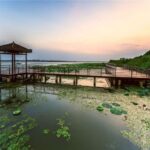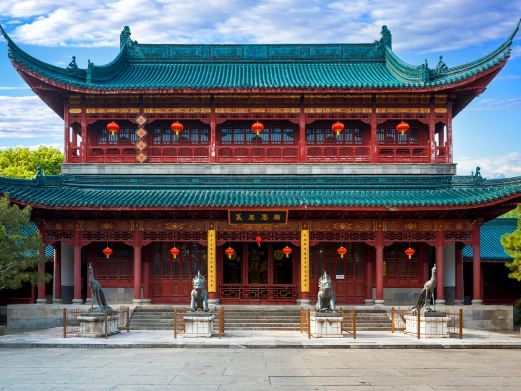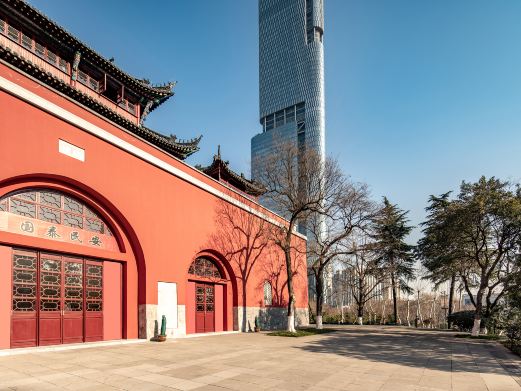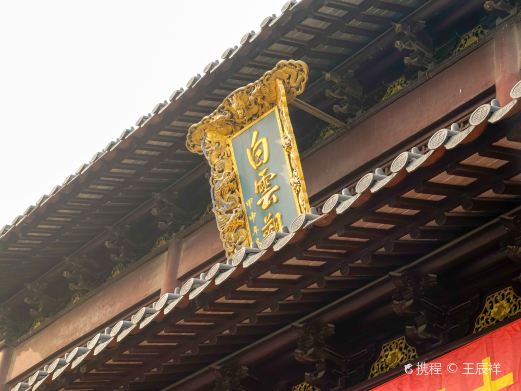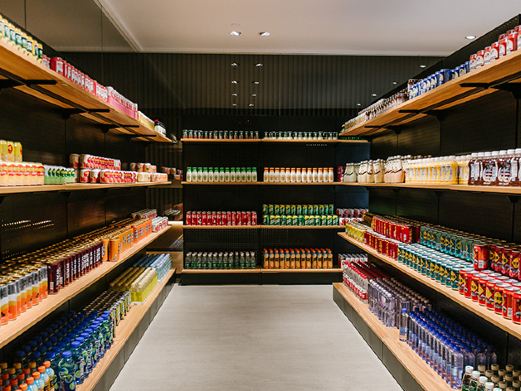Huanxiu Mountain Villa, also known as Yiyuan, is located within the Embroidery Museum and is a class[...]
Huanxiu Mountain Villa, also known as Yiyuan, is located within the Embroidery Museum and is a classical garden primarily featuring artificial mountains. Dominated by mountains and supplemented by pools of water, the garden has a limited number of buildings. Despite its small size, it exudes an imposing presence. The layout is ingeniously designed to integrate lakes, pools, trees, and architecture into a harmonious whole; a single artificial mountain and a bend of water are particularly innovative.
Artificial Mountain: Huanxiu Mountain Villa is renowned as a famous garden in Suzhou primarily due to its artificial mountain. The garden’s lake stone artificial mountain was constructed by Ge Yuliang, a master of mountain stacking during the Qing Qianlong period. Ge’s mountain stacking is unparalleled, covering less than half an acre, yet within a small space, it captures the essence of thousands of crags and ravines.
When viewed from around the mountain, the scenery changes with every step, earning the reputation of ‘unparalleled in the south of the Yangtze River’. The artificial mountain occupies one-third of the garden’s area, positioned towards the east, with its tail extending to the northeast. The mountain features perilous paths, caves, secluded valleys, cliffs, flying bridges, and sheer walls, with a variety of scenes as if natural.
Its main peak rises abruptly to the southeast, and the secondary peak bows to the northwest, with pool water encircling between the two, giving the sensation of a sudden peak rising in a flat plain, towering over the wilderness. The main mountain is divided into front and back parts, with a secluded valley in between, entirely constructed from stacked stones, with steep cliffs and peaks on the outside and caves inside.
The rear mountain, facing the pool, is a lake stone cliff, with only a meter or so of space between it and the front mountain, forming a valley about 5 meters high. The main peak is 7.2 meters high, the valley is approximately 12 meters, and the mountain path is over 60 meters long, winding up and down.

Flying Snow Spring: A famous spring within Suzhou gardens. This spring was created during the Qing Qianlong period when Jiang Kui (styled Jichuan), an external member of the Ministry of Justice, purchased and renovated Huanxiu Mountain Villa. The spring, with its excellent water quality, was named ‘Flying Snow Spring’ after Su Dongpo’s poem about tea brewing, which goes, ‘The fluffy grind emerges as fine pearls falling, dizzily swirling around the bowl like light snow flying’.
Today, on the western side of the garden’s autumn mountain, one can see the words ‘Flying Snow’ inscribed on the stone wall by the pool. The Flying Snow Spring has long been silted up, and its site is now ingeniously used as the source of the large artificial mountain’s mountain stream. The stream features perilous stepping stones, with waterfalls rushing down after rain, entering the pool and the main mountain’s belly.
The stone wall occupies a small area but includes caves, streams, and cliffs, forming a complete structure, complementing the main mountain with one as the main and the other as the secondary, one as the principal and the other as the auxiliary, full of charm. There are steps and a side building connected on the wall. Descending along the mountain rocks from the building, one can reach the water’s edge, with a very steep path.
Wonderfully, at appropriate positions on the rock wall, there are handholds, arranged just right, natural and unobtrusive, which must be admired for the gardener’s extraordinary craftsmanship. At the end of the mountain path, the water’s edge with its stone jetty appears and disappears with the water waves, full of natural interest.

Additionally, behind the artificial mountain, there is a small pavilion, facing the mountain and the water, with a small cliff and stone pool beside it, borrowing the meaning of ‘plain rapids and green pools, with four clear reflections’, hence named ‘Half Pond Autumn Water and One Room Mountain’. From the pavilion, the mountain and cliffs appear as if painted.
The surrounding forest is shady and clear, with gnarled branches and trunks, full of rustic charm.

Leaving the pavilion to the north and going down along the stone steps, the mountain stream flows low, and the peak stones are uneven. There is a road leading to the ‘Buqiu Fang’ in the north of the garden. The south side of this building faces the water. This building has three bays in width and echoes the large hall on the south side of the pool from a distance.
Opening hours: Open from 07:30 to 17:30 from March 1st to October 31st; open from 07:30 to 17:00 from November 1st to February 28th.
Preferential policies:
Children: Those under 6 years old (inclusive) or under 1.4 meters in height can enter for free with valid identity documents.
Minors: Those aged 6 years old (exclusive) to 18 years old (inclusive) can enjoy half-price tickets with valid identity documents.
The elderly: Those aged 70 years old (inclusive) or above can enter for free with valid identity documents. Those aged 60 years old (inclusive) to 70 years old (exclusive) can enjoy half-price tickets with valid identity documents.
Students: Full-time undergraduate and below students can enjoy half-price tickets.
Military personnel: Active-duty soldiers of the People’s Republic of China and retired military cadres can enter for free with valid identity documents.
Disabled people: Disabled people and one accompanying person of severely disabled people can enter for free with valid identity documents.
Preferential objects: Preferential objects with the ‘Preferential Certificate for Veterans of the People’s Republic of China’ and the ‘Preferential Certificate for Martyrs, Military Personnel Died in the Line of Duty, and Surviving Family Members of Military Personnel Who Died of Illnesses’ (except for inner gardens, charged items in the park and night tour projects) can enter for free.
Suzhou medical staff: Within seven days (from May 12th to 18th and from August 19th to 25th) starting from International Nurses Day on May 12th and Chinese Doctors’ Day on August 19th every year, Suzhou medical staff can visit scenic spots for free. When Suzhou medical staff visit scenic spots, please show ‘personal ID card’ + ‘Suzhou Medical Staff Free Park Card (electronic card)’, and they can enter the park directly without reservation and the first entrance fee is waived.
Supplementary note: The above information is for reference only. The specific information is subject to the publicity of the scenic spot.
Must-see tips
Historical evolution: The construction history of Huánxiù Villa can be traced back to the Jin Dynasty when the Wang Xun brothers donated their houses to build Jingde Temple. Later, it became the Jingu Garden of Qian Yuanliao, the son of Qian Liu, the king of Wuyue State during the Five Dynasties. In the Song Dynasty, it was the medicine garden of the writer Zhu Changwen. After that, it had its ups and downs.
During the Jiajing period of the Ming Dynasty, it was successively changed into Xue Dao Academy and Grain Supervision Department. During the Wanli period, it was the residence of Shen Shixing, a grand secretary. At the end of the Ming Dynasty and the beginning of the Qing Dynasty, Shen Jikui, the descendant, built Quyuan Garden. During the Qianlong period of the Qing Dynasty, it was the residence of Jiang Ji, a deputy chief of the Ministry of Punishments.
Jiang built the ‘Qiuzi Tower’ and piled up rocks behind the building to form a mountain. After digging three feet into the ground, there was a clear spring flowing and overflowing to form a pool. The spring was named ‘Flying Snow’, and houses and pavilions were built in it. Later, it successively became the residence of Bi Yuan, a minister, and Sun Shiyi, a grand secretary. Sun Jun, the descendant of Sun, with the elegant name of Linquan, invited Ge Yuliang, a famous rockery builder, to reconstruct this garden in the twelfth year of Jiaqing.
Guo Yuliang’s rockery, constructed on a mere half-acre of land, exudes an aura of vastness as if spanning thousands of miles. From then on, the garden became renowned for its artificial mountains. In the 29th year of the Daoguang era (AD 1847), Wang Weiren purchased and established the Wang family ancestral hall, set up the Geng Yin Yi Zhuang, and renovated the northeastern garden. This garden became part of the Wang family ancestral hall known as ‘Geng Yun Mountain Villa’ and was renamed ‘Huanxiu Mountain Villa’, also known as ‘Yi Garden’.
Over time, much was destroyed, and by 1949, only one mountain, one pond, and a ‘Bu Qiu Fang’ pavilion remained. From June 1984 to October 1985, the Suzhou Garden Bureau and the Embroidery Research Institute jointly funded a large-scale restoration. The main attractions that were restored include the Huanxiu Mountain Villa’s Four-Sided Hall, You Gu Hall, Wen Quan Pavilion, and the Side Building.



